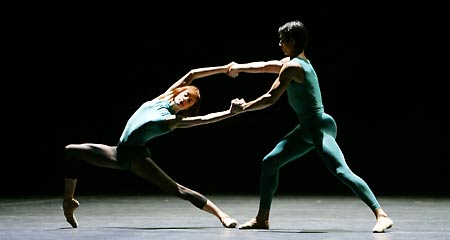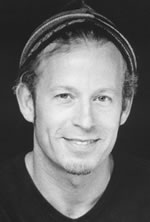UC Berkeley Press Release
 Muriel Maffre (left), shown dancing with Pierre-Francois Vilanoba, will perform "Ballet Mori" to music generated by the Hayward Fault . (SF Ballet photo, © Chris Hardy) |
1906 earthquake centennial inspires ballet performed to live seismic data
BERKELEY – The sound of the Earth moving is too subtle for the human ear and too unpredictable to dance to, for most ballerinas.
But that will change for eight minutes on Tuesday, April 4, when San Francisco Ballet principal dancer Muriel Maffre performs to sounds triggered by seismic movements in the Hayward Fault. Those signals will be transmitted via the Internet from the University of California, Berkeley, to San Francisco's War Memorial Opera House.
"Ballet Mori" is the brainchild of Ken Goldberg, who is an artist and a UC Berkeley professor of industrial engineering, computer science and robotics. He and his team have engineered a system that allows seismic waves to be transmitted into a concert hall in real time to activate audible sounds, dance and lighting.
 Ken Goldberg (Troy Kendall photo) |
"To have nature directly admitted into the San Francisco Opera House is pretty risky because of its unpredictability," Goldberg said. "As far as we know, nothing like this has ever been done."
The solo performance is part of a program commemorating the centennial of the 1906 earthquake. It brings together such virtuosos as composer Randall Packer and San Francisco Ballet principal dancer Yuri Possokhov, who developed the vocabulary of dance movements that Maffre will perform.
On stage, Maffre will improvise to sounds measured by a UC Berkeley Streckeisen STS-1 seismometer and transformed in real time by a system that Goldberg developed with Vijay Vasudevan, a UC Berkeley senior majoring in computer science. The signals will trigger natural sounds such as thunder claps, crashing waves and waterfalls.
"The Earth will control these sounds just as a conductor controls an orchestra by moving a baton," Goldberg said.
Goldberg, 44, has been straddling the worlds of art and science since his childhood in a Pennsylvania steel mill town. His family encouraged him to get an engineering degree, which he did. But he was constantly drawn to the arts, particularly to works that reflect the relationship between nature and technology. When he came to UC Berkeley in 1995, he developed a series of projects that explored that dynamic.
"I think there's a fantasy around technology, that technology is being promoted and envisioned as larger than it really is," Goldberg said. "I try to make people think about the limitations of technology in a way that isn't obvious or didactic."
As a newcomer to California, he was struck by the blasť attitude of many in the Bay Area toward earthquakes. For instance, no one he knew had an earthquake kit. As he got more interested in seismology, he talked with members of UC Berkeley's McCone Hall seismology lab about his plans to create an artistic expression of the data and put it on the Internet. They agreed to help him, he said, but told him, "You must respect the data."
Goldberg understood exactly what they meant: "They were essentially giving me valuable data - live and with no delay," he said. Indeed, he said, he could have manipulated the data and pulled a "War of the Worlds" stunt.
"I promised not to do that. I was very careful," he said.
His first art project presenting live seismic data, in 1998, was called Memento Mori, a reference to the Renaissance-era motif on flesh and mortality, which for Goldberg evoked the frailty of humans against the power of nature.
That same year, during an art, technology and culture colloquium at UC Berkeley, he met composer Randall Packer, who proposed sonifying Memento Mori's seismic data. The project debuted in Tokyo in 1999 and was renamed Mori, which means "forest sanctuary" in Japanese. The Mori installation then traveled to Los Angeles, Austin and Manhattan.
As the centennial of the 1906 earthquake drew closer, Goldberg wanted to contribute something. "I wanted to create something that would take the same concept of live data and take it to another level," he said.
A year ago, he had the good fortune to meet San Francisco Ballet dancer Muriel Maffre at a dinner party. They talked about the Earth Art movement, and then he described his Mori project.
"I said, 'Would you ever dance to the sound of the Earth?'" Goldberg said. "She looked at me and said, 'Yes.'"
Against all odds, he said, the performance was approved by San Francisco Ballet director Helgi Tomasson.
Now, with the performance less than a week away, he has lots to worry about. "The computers have to talk to each other. The networks have to work. There are many ingredients," Goldberg said. "With all our fancy computers and networks, we still can't predict the Earth."
And that's just the point.
"This is a reminder about our vulnerability, a memento mori," he said.

